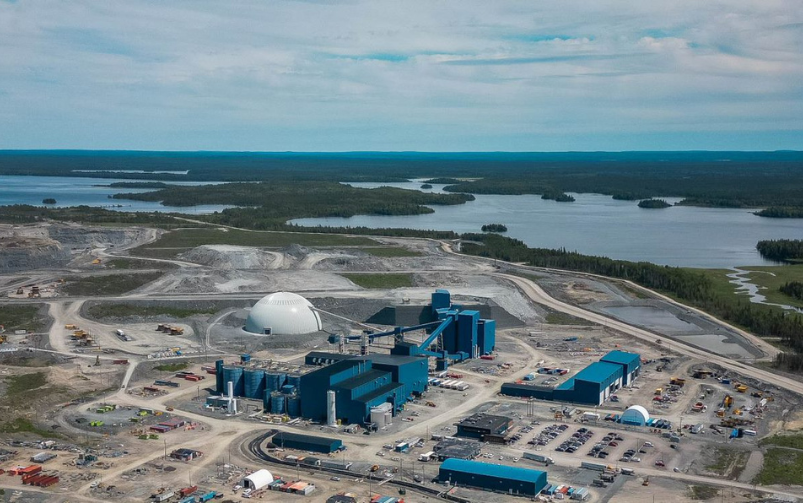Alamos Gold shared that the integration of its Island Gold mine (pictured) and Magino mine is steadily progressing after it wrapped up its acquisition of Argonaut Gold earlier this year. Courtesy of Alamos Gold.
Welcome back to your weekly mining news recap, where we catch you up on some of the news you may have missed. This week’s headlines include First Nation opposition to Osisko Development’s Cariboo gold project in B.C., a funding boost for Ontario junior mining companies and the detention of more mining executives in Mali.
U.S. miner Piedmont Lithium announced a new production record at the North American Lithium (NAL) operation in Quebec, as reported by Mining.com. The mine produced around 52,100 tonnes of spodumene concentrate in the third quarter, which is up five per cent from the previous quarter, when it produced a record 49,660 tonnes. Piedmont has a 25 per cent stake in NAL in a joint venture with Australia’s Sayona Mining. Despite these positive results, Piedmont has reduced its workforce by almost half this year amid falling lithium prices.
Alamos Gold reported record production in its third quarter results with 152,000 ounces of gold produced from its mines in Mexico and Ontario, up nine per cent from the second quarter, which it said was fuelled by solid performance at its Island Gold and Magino mines in Dubreuilville, Ontario. Following its acquisition of Argonaut Gold, Alamos is working on integrating its Island Gold and Magino mines. The company expects the addition of the Magino mine to its Island Gold project will increase production by about 20 per cent. The company announced revenue of US$361 million and reported net earnings of US$84.5 million for the quarter.
A recent federal audit of Canada’s critical minerals strategy highlighted concerns over whether the government has thoroughly assessed mining’s impact on the environment, biodiversity and Indigenous communities, as reported by CBC News. It made several recommendations in its report, including that the strategy should have indicators and targets to measure progress towards Indigenous reconciliation not just in terms of revenue-sharing and job opportunities, but also regarding social measures such as improvements in community well-being. The federal government acknowledged the recommendations, adding that many of them are being addressed.
As Osisko Development Corp. eagerly awaits final approval from the B.C. government for its Cariboo gold project, the Xatśūll First Nation has raised concerns over the project’s potential environmental impacts and the terms of its economic benefits agreement, as reported by Business in Vancouver. The First Nation said it is considering legal action if these issues are not addressed by the company. Osisko has stated that it is committed to ongoing engagement with the Xatśūll First Nation as the permitting process advances.
The Ontario government is providing funding of $13 million through the province’s junior exploration program to support 84 companies, with 19 in the Timmins area or north of it, as reported by CTV News. The investment aims to encourage small Ontario mining companies to take on exploration risks and drive grassroots exploration. So far, the province has committed $35 million over four years to the Ontario Junior Exploration Program, though there have been calls for more government support. Of the 84 projects receiving support, 62 of them are critical minerals projects.
Terence Holohan, the CEO of Resolute Mining, along with two other executives from the company, were detained on Nov. 8 by Mali’s military junta during a business trip, as reported by Reuters. Resolute owns the Syama gold mine in the southwest of the country. This news follows the brief detention of four Barrick Gold senior employees in Mali in September, highlighting escalating tensions between Mali’s government and international mining companies. Mali’s junta continues to seek greater control over gold revenue and is renegotiating existing mining contracts that would allow the government to increase its stake in projects.
Barrick Gold is among several miners that have struggled to benefit from the rise in gold prices amid increased mining costs and lower output rates, as reported by Bloomberg. Despite CEO Mark Bristow’s attempts to improve the company’s balance sheet and diversify its assets, the company has underperformed when contrasted with gold producers such as Agnico Eagle and Newmont due to missed production targets, rising costs and political instability at some of its mines.
The fate of Paladin Energy’s proposed $1.14 billion takeover of Fission Uranium remains uncertain as the deal undergoes a national security review by the Canadian government, as reported by The Globe and Mail. Chinese influence is on both sides of the deal. Paladin’s ties to China include a 25 per cent stake in its Langer Heinrich mine in Namibia by China National Nuclear Corporation (CNNC) and Fission’s largest shareholder is China Uranium Development.
Chinese copper smelters are under pressure to slow down expansion, as smelting capacity continues to grow faster than mined copper supply, as reported by Bloomberg. Western governments fear the continued construction of smelters in China will concentrate copper production even further in the country, where state-owned smelters have the resources to survive the current downturn in profitability better than other jurisdictions.
To address the Canadian mining industry’s dire labour shortage and skills gap, Will Meyer, director of communications and career development at MiHR, argued in the November issue of CIM Magazine that a pan-Canadian, sectoral approach is needed. At CIM CONNECT 2024, professionals proposed a national coalition bringing together industry, education and government to tackle issues like declining post-secondary enrollment in mining programs and attracting youth and equity-deserving groups to mining. Meyer believes a unified national strategy is crucial to shift negative perceptions, raise awareness about the industry and promote mining careers, rather than relying on organization- or region-specific initiatives.
To support emergency response teams (ERTs) in managing the emotional toll that comes with handling incidents, especially those affecting people they know, Nutrien launched mental health training last year at its Cory potash mine in Saskatchewan, as reported by Tijana Mitrovic for the November issue of CIM Magazine. The training, created in collaboration with local mental health professionals, aims to help ERTs manage their emotions, become more resilient and prioritize their mental health after attending to an emergency. Following positive feedback from the Cory mine, Nutrien is expanding the training to additional sites.
That’s all for this week. If you’ve got feedback, you can always reach us at editor@cim.org. If you’ve got something to add, why not join the conversation on our Facebook, Twitter, LinkedIn or Instagram pages?




